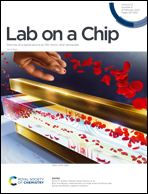A continuous flow PCR array microfluidic chip applied for simultaneous amplification of target genes of periodontal pathogens†
Abstract
The concept of time to place conversion makes using a continuous flow polymerase chain reaction (CF-PCR) microfluidic chip an ideal way to reduce the time required for amplification of target genes; however, it also brings about low throughput amplicons. Although multiplex PCR can simultaneously amplify more than one target gene in the chip, it may easily induce false positives because of cross-reactions. To circumvent this problem, we herein fabricated a microfluidic system based on a CF-PCR array microfluidic chip. By dividing the chip into three parts, we successfully amplified target genes of Porphyromonas gingivalis (P.g), Tannerella forsythia (T.f) and Treponema denticola (T.d). The results demonstrated that the minimum amplification time required for P.g, T.d and T.f was 2′07′′, 2′51′′ and 5′32′′, respectively. The target genes of P.g, T.d and T.f can be simultaneously amplified in less than 8′05′′. Such a work may provide a clue to the development of a high throughput CF-PCR microfluidic system, which is crucial for point of care testing for simultaneous detection of various pathogens.



 Please wait while we load your content...
Please wait while we load your content...